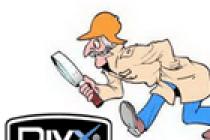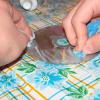Electromagnetic relays
The most important element of all electromagnetic relays is the contact
system. Provide the same conditions at the point of electrical contact
the passage of current, which a solid conductor has, is almost impossible,
as a result of which contact connections are the weakest point of any
electrical apparatus and require special attention during operation.
© Povny A.V.
| |
|
The value of the contact resistance is influenced by the series
reasons: it depends on the material of the contact connection, on the pressure,
tested
contact
elements,
magnitudes
surface
contact and its condition and the temperature of the contact. Electricity,
released during the passage of current through the contact elements, partially
turns into heat, heating these elements in the process of their work and
dissipating into environment... Excessive heating of the contacts often
leads to their oxidation, and the oxide films of most of the metals do not
electrical wiring and increase the value of the transition resistance.
Reliability of relay operation is highly dependent on quality
adjusting the contact system and on the state of the contacts. If the relay contacts
vibrate, then during operation they burn and collapse, and sometimes
welded.
The operation of the relay contacts is characterized by the values of the solution between
movable and fixed contacts, failure and pressing force of contacts.
Each metal is characterized by a certain optimal value
providing
ultimate
pressure,
whom
magnitude
transitional
resistance
practically
changes
further
increasing the force of pressing the contacts.
contacts
least
distance
contact
the surfaces of the fully open relay contacts.
Contact failure is the distance the movable travels
the contact system of the relay after touching the contacts (the distance over which
Other e-books electrical engineering: http://electrolibrary.info
© Povny A.V.
|
http://electricalschool.info/ - School for an electrician.
Articles, tips, helpful information.
the contact system moves if the stationary contact system
mentally remove). Contact failure [mm] is the technical passport value,
providing pressing force. During operation, the contact wears out
(friction, burnout of a part of the contact due to an electric arc) and contact
pressing decreases, which means that contact resistance increases and increases
danger of welding. Therefore, the failure of contacts during operation
controlled.
The solution and the failure of the relay contacts are determined using a measuring
tool. Measured values of solutions, dips and clicks for each
much
differ
the respective
given in the technical data sheets of the relay. Reducing the dip is acceptable
contacts by 50% of the initial value given in the documentation of the plant
manufacturer.
Clear and reliable operation of relay contacts without sparking, welding,
melting and bouncing depends both on their mechanical adjustment and on
electrical adjustment of the relay as a whole. Therefore, finally contacts
regulate
underflow
settings
electrical
parameters
having previously carried out the mechanical adjustment of the contacts.
Before adjustment, dirty burnt contacts are washed with alcohol.
or cleaned with a velvet file and polished. Flush them with gasoline
ammonia or other detergent is not recommended.
The contact relays are adjusted so that there is no vibration and
bouncing of movable contacts onto fixed ones, and when straightening
the fixed contacts with tweezers avoid breaking the contact springs. Deflection
springs of fixed contacts depends on their elasticity, the angle of meeting and
Other electronic books on electrical engineering: http://electrolibrary.info
© Povny A.V.
|
http://electricalschool.info/ - School for an electrician.
Articles, advice, useful information.
joint travel of contacts, as well as from their pre-tension
created by limiting stops and anti-vibration plates.
The reason
unacceptable
vibrations
contacts
mechanical failures of the relay, which do not manifest themselves at low currents. Usually
cause
vibrations
is an
wrong
position
relative to the armature or misalignment of the armature axis relative to the magnetic flux axis due to
for misalignment of holes for thrust bearings. In the first case, eliminate
large longitudinal and transverse clearances, replace the return spring
contact bridge, eliminate the misalignment of the axis of the contact bridge or magnetic
relay systems. In other cases, mechanical adjustment is also carried out.
contacts.
Automotive relays
Electromagnetic relays on relay automatic telephone exchanges
Other electronic books on electrical engineering: http://electrolibrary.info
© Povny A.V.
|
|
http://electricalschool.info/ - School for an electrician.
Articles, advice, useful information.
This is also an electromagnetic relay
The contactor must be installed vertically, since it is disconnected by the weight of the moving system. A deviation from the vertical position by an angle of up to 5 o is allowed. The tightening of the bolts and nuts fixing the contactor parts and the free movement of the moving system should be checked.
The contacts of the contactors, both at the moment of initial contact and after switching on, must touch linearly, and the contact must be at least 75% of the contact width. It is not necessary to achieve contact along the plane.
When switched on, the movable contact must roll over the fixed one.
The contacts of the contactors operating in continuous mode are made with silver soldered inserts. All contacts are removable for replacement. If or if copper droplets (beads) have formed on their surface, then the surface must be slightly cleaned, trying to remove as little copper as possible. In this case, the radius of curvature of the fixed contact should not change.
It is not allowed to clean the contacts with an emery cloth, as the emery crystals will cut into the copper. Do not lubricate the contacts.
It is necessary to ensure that the contacts have normal pressure, failure and solutions (see tables 1 and 2).
Table 1
Pressing contacts, kg
Overall dimensions Initial The final
main contacts contact block main contacts contact block
2
0,7-0,9
0,07
0,9-1,1
0,15
3
1,8-2,3
0,07
2,3-3,6
0,15
4
3,6-5,1
0,07
5,5-7,5
0,15
5
7-9,8
0,07
10-13,5
0,15
table 2
Failure of contacts Minimum contact gap, mm
Overall dimensions main contacts contact block main contacts contact block
2
2,5+/-0,5
3-4
11
10
3
3+/-0,5
3-4
14
10
4
4,5+/-0,5
3-4
16
10
5
5,5+/-0,5
3-4
18
10
The meanings of the final pressures and solutions in this table are given for new contacts. As the contacts wear, the final pressure decreases. If the gap is less than 2.5 mm with new contacts, the contacts should be adjusted. If during operation the dip becomes less than 1.2 mm, the contacts should be replaced. The initial pressure values for both new and worn contacts must be observed.
During repairs, the simultaneous initial and final pressing of the contacts is made by laying washers under the shaped pin on which the spring rests.
Deion extinguishing interrupters have a grating of steel copper-plated arc-extinguishing plates inside. These plates should be in place - in the grooves and should not touch each other. The magnetic extinguishing chamber uses an arc-extinguishing coil and a core that surrounds the arc-extinguishing chamber from the outside. The camera must be properly secured to the contactor. Movable ones should not touch the walls of the chamber.
The electromagnetic system consists of an armature, an W-shaped core and a retraction coil. The extreme poles of the armature and the core must fit snugly together.  With the anchor pressed against the core, the strip of papyrus paper should not move between the extreme poles. If the surface touches less than 60-70%, then the core needs to be adjusted. Scabbing must be done along the layers of the mixture and at the same time it is impossible to remove a large layer, since the required gap between the middle protrusions of the magnetic circuit may decrease. The pull-in electromagnet generates a slight noise during operation, similar to the hum of a transformer. Severe humming can be caused by a malfunction of the magnet system or loose screws.
With the anchor pressed against the core, the strip of papyrus paper should not move between the extreme poles. If the surface touches less than 60-70%, then the core needs to be adjusted. Scabbing must be done along the layers of the mixture and at the same time it is impossible to remove a large layer, since the required gap between the middle protrusions of the magnetic circuit may decrease. The pull-in electromagnet generates a slight noise during operation, similar to the hum of a transformer. Severe humming can be caused by a malfunction of the magnet system or loose screws.
Probable causes of humming:
a) the screws securing the armature and the core are poorly tightened;
b) a short-circuited loop has burst or is missing;
c) contacts are overly pressed;
d) the anchor is skewed or does not fit tightly to the core due to contamination of the contact surface, or with nicks and curvature of the contact planes.
Short-circuited loops at the extreme poles can heat up to 200 ° C.
The contactor housing must be grounded.
It is customary to call a contact failure the distance by which the point of contact of the moving contact with the fixed contact can be displaced from the position of complete closure if the fixed contact is removed. Since it is practically difficult to determine the size of the wire, it is limited to checking the gap formed between the plate on which the fixed contact is fixed and the contact holder bracket when the contacts are closed.
Initial pressure is the force created by the contact spring at the point of initial contact of the contacts. If the initial pressure is insufficient, the contacts may be welded, and if the required initial pressure is exceeded, the clarity of the contactor operation is impaired. Initial press test is performed as follows.
The line of contact of the contacts is preliminarily marked on the moving contact. When changing the initial push, the contacts must be in the open state.
A strip of tissue paper is clamped between the movable contact and the plate on which the movable contact is installed. A dynamometer hook is threaded into the opening of the movable contact, which is pulled until the paper can be freely moved by pulling it out by hand. The dynamometer readings at this moment give the value of the initial depression.
The final push is the force generated by the contact spring.
The check of the final pressing is carried out with the contactor fully switched on, similar to the measurement, only in this case the paper is laid between the movable and fixed contact.
Adjustment of the amount of pressing of the contacts is made by changing the position of the bracket of the holders of the movable contacts by tightening or loosening the nuts.
Operating principle:
The contactor works as follows. When voltage is applied to the coil target, the core attracts the armature, which presses the moving contacts to the fixed ones. The core rests on shock-absorbing springs, which soften the impact of the armature on the core when the contactor is switched on. The armature returns to the off position by means of a spring. The path of movement of the armature rotating on the axis is limited by the stop. When the armature is attracted to the core, the movable contacts are pressed against the fixed contacts and close the auxiliary contacts, which bypass the "Start" button so that after the motor starts it can be released.
The principle of operation of the Switching device:
To prevent vibrations of the contacts, the contact spring creates a pre-pressure equal to half the final contact force. Vibration is greatly influenced by the rigidity of the fixed contact attachment and the vibration resistance of the entire contact as a whole. In this respect, the design of the KPV-600 series is very successful. the fixed contact is rigidly attached to the bracket. One end of the arc quenching coil is attached to the same bracket. The second end of the coil, together with the lead, is securely fastened to an insulating plastic base. The latter is attached to a strong steel bracket, which is the base of the apparatus. The movable contact is made in the form of a thick plate. The lower end of the plate has the ability to pivot about the pivot point. Thanks to this, the plate can roll over the crack of the stationary contact. The output is connected to the moving contact using a flexible conductor (connection). Contact pressure is generated by a spring.
When the contacts are worn out, the cracker is replaced with a new one, and the movable contact plate is rotated 180 ° and its undamaged side is used in work.
To reduce the melting of the main contacts by the arc at currents of more than 50 A, the contactor has arcing contacts - horns. Under the influence magnetic field arc extinguishing device pivot points the arcs move quickly to the bracket connected to the fixed contact and to the protective horn of the movable contact. Return the anchor to starting position produced by a spring.
The main parameter of the contact is the rated current, which determines the dimensions of the contactor.
The KPV series of contacts has a design with an NC main contact. Closing is performed due to the action of a spring, and opening is due to the force developed by an electromagnet.
The rated current of the contactor is the current of intermittent-continuous operation. In this mode, the contactor is on for no more than 8 hours. After this interval, the device must be turned on and off several times (to clean the contacts from copper oxide). Then the device turns on again.
KTPV-500 type, has a direct current electromagnet, movable contacts are isolated from the case, which makes it safer to service the device.
The movable contact with the spring is fixed on an insulating arm connected to the contactor shaft. Due to the easier extinguishing of the alternating current arc, the contact gap can be taken small. Reducing the solution makes it possible to approach the axis of rotation. The small distance of the point of contact of the contacts from the axis of rotation allows to reduce the force of the electromagnet required to turn on the contact, which makes it possible to reduce the size and power consumption of the magnet.
The movable contact and the armature of the electromagnet are interconnected through the contactor shaft. Unlike DC contactors, the movable contact in the KPV-600 contactor does not have rolling. The device is disconnected under the action of the contact springs and the forces of the weight of the moving parts.
The principle of operation of the arc extinguishing device.
In direct current contactors, devices with electromagnetic blowing are most widely used. When the magnetic field interacts with the arc, an electrodynamic force arises that moves the arc at high speed. To improve the cooling of the arc, it is driven into a slot made of an arc-resistant material with high thermal conductivity.
When the contacts diverge, an arc arises between them. An arc can be viewed as a current carrying conductor. The coil creates a c.f., under the action of which a current is generated. This flow passes through the coil core, pole pieces and the air gap in which the arc is burning.
To ensure the conditions for extinguishing the arc, it is necessary to raise the current-voltage characteristic of the arc with increasing current.
In the region of low currents, with increasing current, the contact solution required for quenching increases. At a given speed of their movement, more time is required to reach the required solution. In the region of high currents, the quenching process is determined by electrodynamic forces. The higher the speed of stretching the arc by dynamic forces, the less time it takes for the arc to reach its critical length.
In high-frequency installations, to ensure normal operating conditions for generators, cos φ circuits tend to be closer to unity.
For reliable and fast extinguishing of the arc in the area of low currents, low current contactors with replaceable magnetic blast coils are used. These coils have a rated current of 1.5 - 40 A. At a low cut-off current, a coil is installed with a large number of turns, due to which the necessary magnetic field is created to extinguish the arc in a short time.
The following requirements are imposed on the contact material:
1. High electrical and thermal conductivity.
2. Resistant to corrosion in air and other gases.
3. Resistant to high resistivity films.
4. Low hardness to reduce the required pressing force.
5. High hardness to reduce mechanical wear during frequent switching on and off.
6. Low erosion.
7. High arc resistance (melting point).
8. High values of current and voltage required for arcing.
9. Easy handling, low cost.
The properties of some of the contact materials are discussed below.
Copper. Positive properties: high electrical conductivity and thermal conductivity, sufficient hardness, which makes it possible to use with frequent switching on and off, rather high values U o and I o, simplicity of technology, low cost.
Disadvantages: low melting point, when working in air, it is covered with a layer of strong oxides with high resistance, requires rather high pressing forces. To protect copper from oxidation, the surface of the contacts is electrolytically coated with a layer of silver 20-30 microns thick. Silver plates are sometimes placed on the main contacts (in devices that are turned on relatively rarely). It is used as a material for flat and round buses, contacts of high voltage devices, contactors, automatic devices, etc. Due to low arc resistance, it is undesirable to use it in devices that turn off a powerful arc and have a large number of starts per hour.
Silver... Positive properties: high electrical and thermal conductivity, the silver oxide film has low mechanical strength and is rapidly destroyed when the contact point is heated. The contact of silver is stable, due to its low mechanical strength, small presses are sufficient (applied when pressed 0.05 N and higher). Stability of contact, low contact resistance are characteristic properties of silver.
Negative properties: low arc resistance and insufficient hardness of silver prevent its use in the presence of a powerful arc and with frequent switching on and off.
It is used in relays and contactors at currents up to 20 A. At high currents up to 10 kA, silver is used as a material for main contacts operating without an arc.
Aluminum. This material has a fairly high electrical and thermal conductivity. Due to its low density, the current-carrying part of a circular cross-section made of aluminum for the same current as a copper conductor has almost 48% less mass. This allows you to reduce the weight of the apparatus.
Disadvantages of aluminum: the formation of films with high mechanical strength and high resistance in air and in active media; low arc resistance (the melting point is much lower than that of copper and silver); low mechanical strength; on contact with copper, steam is formed, which is subject to strong electrochemical corrosion. In this regard, when combined with copper, aluminum must be electrolytically coated with a thin layer of copper, or both metals must be coated with silver.
Aluminum and its alloys (duralumin, silumin) are mainly used as a material for tires and structural parts of devices.
Tungsten. The positive properties of tungsten are: high arc resistance, high resistance to erosion, welding. The high hardness of tungsten allows it to be used with frequent switching on and off.
The disadvantages of tungsten are: high resistivity, low thermal conductivity, formation of strong oxide and sulfide films. Due to their high mechanical strength and film formation, tungsten contacts require a lot of pressure.
Relays for small currents with a slight pressure use corrosion-resistant materials - gold, platinum, palladium and their alloys.
Sintered materials. An examination of the properties of pure metals shows that none of them fully satisfies all the requirements for breaking contacts.
The main required properties of the contact material - high electrical conductivity and arc resistance - cannot be obtained by alloying materials such as silver and tungsten, copper and tungsten, since these metals do not form alloys. Materials with the desired properties are obtained by powder metallurgy (cermets). The physical properties of metals in the manufacture of metal-ceramic contacts are preserved. The arc resistance of ceramics is imparted by such metals as tungsten and molybdenum. To obtain a low contact resistance, silver or copper is used as the second component. The more tungsten in the material, the higher the arc resistance, mechanical strength, and resistance to welding. But, accordingly, the resistance of the contacts increases, and the thermal conductivity decreases. Usually, cermets with a tungsten content above 50% are used for heavily loaded devices that switch off large short-circuit currents.
For contacts of high-voltage devices, the most widely used metal ceramics are KMK-A60, KMK-A61, MK-B20, KMK-B21.
In low voltage devices, the most widely used metal ceramics KMK-A10 made of silver and cadmium oxide CdO. A distinctive feature of this material is the dissociation of CdO into cadmium and oxygen vapors. The evolved gas forces the arc to move rapidly over the contact surface, which significantly lowers the contact temperature and contributes to the deionization of the arc.
The cermet, consisting of silver and 10% copper oxide, MK-A20 is even more resistant to wear than KMK-A10.
The silver-nickel contacts are well machined and highly resistant to electrical wear. The contacts provide a low and stable contact resistance in operation. However, they are easier to weld than contacts made of KMK-A60, KMK-B20, KMK-A10.
Due to their high resistance to welding, silver-graphite and copper-graphite contacts are used as arcing contacts.
In conclusion, it should be noted that although the use of cermets increases the cost of the equipment in operation, these "extra" costs quickly pay off, since the service life of the apparatus increases, the time between revisions increases, and the reliability increases significantly.
Under the failure of contacts the value of the displacement of the movable contact at the level of its point of contact with the fixed contact is meant if the fixed contact is removed.
Failure of the contacts ensures reliable closure of the circuit when the thickness of the contacts decreases due to the burnout of their material under the action of an electric arc. The magnitude of the dip determines the margin of contact material for wear during the operation of the contactor.
After contact of the contacts, the moving contact rolls over the fixed one. The contact spring creates a certain pressure in the contacts, therefore, when rolling, the destruction of oxide films and other chemical compounds that may appear on the surface of the contacts occurs. The points of contact of the contacts during rolling move to new places of the contact surface that have not been exposed to the arc and are therefore "cleaner". All this reduces the transient resistance of the contacts and improves their working conditions. At the same time, rolling increases the mechanical wear of the contacts (contacts wear out).
Contact solution is called the distance between movable and fixed contacts in the disconnected state of the contactor. The contact gap usually ranges from 1 to 20 mm. The lower the contact gap, the shorter the armature travel of the drive electromagnet. This leads to a decrease in the working air gap in the electromagnet, magnetic resistance, magnetizing force, power of the electromagnet coil and its dimensions. The minimum value of the contact solution is determined by: technological and operational conditions, the possibility of forming a metal bridge between the contacts when the current circuit is broken, the conditions for eliminating the possibility of closing the contacts when the mobile system rebounds from the stop when the device is turned off. The contact gap must also be sufficient to provide conditions for reliable arc extinguishing at low currents.
Solution of contacts of electronic devices
In low voltage electronic devices, the contact solution is mainly determined by the arc extinguishing criteria and only at significant voltages (above 500 V) does its value begin to depend on the voltage between the contacts. Experiments show that the arc leaves the contacts already at a solution of 1 - 2 mm.
More unfavorable conditions for extinguishing the arc are obtained with a constant current, the dynamic forces of the arc are so significant that the arc moves intensively and extinguishes already with a solution of 2 - 5 mm.
According to these experiments, it can be considered that in the presence of a magnetic field for extinguishing the arc at a voltage of up to 500 V, it is possible to take a solution value of 10 - 12 mm for a constant current, for an alternating current, 6 - 7 mm is taken for all current values. An excessive increase in the solution is not necessary, because it leads to an increase in the stroke of the contact parts of the apparatus, and, consequently, to an increase in the dimensions of the apparatus.
The presence of a bridge contact with 2 breaks makes it possible to reduce the contact stroke, while maintaining the total value of the solution. In this case, a solution of 4 - 5 mm is usually taken for each break. Particularly excellent arc extinguishing results are obtained with an AC bridge contact. Excessive solution reduction (less than 4 - 5 mm) is usually not done, because errors in the manufacture of individual parts can significantly affect the size of the solution. As the need to obtain small mixtures, it is necessary to anticipate the possibility of adjusting it, which complicates the design.
If the contacts work in the criteria when they can be heavily contaminated, the solution must be increased.
Usually the solution increases and. for contacts opening a circuit with high inductance, because at the moment of extinction of the arc, significant overvoltages occur and with a small gap, the arc can reignite. The solution also increases for the contacts of protective devices in order to increase their reliability.
The solution grows significantly with an increase in the frequency of the alternating current, because the rate of voltage rise after the arc is extinguished is very high, the distance between the contacts does not have time to deionize and the arc ignites again.
The magnitude of the solution on an alternating current of the highest frequency is usually determined experimentally and very much depends on the design of the contacts and the arc chute. At voltages of 500-1000 V, the size of the solution is usually taken as 16-25 mm. Huge values apply to contacts that turn off circuits with higher inductance and huge currents.

The contacts wear out during operation. In order to ensure their reliable contact for a long time, the kinematics of the electronic device is made in such a way that the contacts touch earlier than the movable system (moving system of movable contacts) reaches the stop. The contact is attached to the moving system via a spring. Due to this, after contact with the fixed contact, the movable contact stops, and the movable system moves forward until it stops, additionally compressing the contact spring.
Thus, if the fixed contact is removed with the closed position of the movable system, then the movable contact will be displaced by a certain distance, called a failure. Failure determines the margin for contact wear at a given number of operations. With other equal criteria, a larger dip provides a higher wear resistance, i.e. longer service life. But a bigger failure usually requires a stronger drive system.
Contact push- the force compressing the contacts in the place of their contact. Distinguish between the initial pressing at the moment of initial contact of the contacts, when the dip is equal to zero, and the final pressing at the complete failure of the contacts. As the contacts wear out, the failure is miniaturized, and, as it follows, the additional compression of the spring. The final press is closer to the original. So Makar, initial pressure is one of the main characteristics in which the contact must remain functional.
 The main function of the failure is to compensate for the wear of the contacts, therefore the magnitude of the failure is determined first by the value of the greatest wear of the contacts, which is usually taken: for copper contacts - for each contact up to half of its thickness (total wear is the total thickness of the 1st contact); for contacts with solders - Until the soldering is completely worn out (complete wear is the total thickness of the soldering of the movable and fixed contacts).
The main function of the failure is to compensate for the wear of the contacts, therefore the magnitude of the failure is determined first by the value of the greatest wear of the contacts, which is usually taken: for copper contacts - for each contact up to half of its thickness (total wear is the total thickness of the 1st contact); for contacts with solders - Until the soldering is completely worn out (complete wear is the total thickness of the soldering of the movable and fixed contacts).
In the case of a contact grinding process, especially rolling, the magnitude of the dip is very often significantly greater than the maximum wear and is determined by the kinematics of the moving contact, which ensures the required rolling and slippage. In these cases, in order to reduce the total travel of the movable contact, the axis of rotation of the movable contact holder can be positioned closer to the contact surface.
The values of the little permissible contact pressure are determined from the criterion for maintaining a measured contact resistance. If special measures are taken to maintain a measured contact resistance, the values of small contact pressure can be reduced. So, in special compact equipment, the contact material of which does not give an oxide film and the contacts are completely firmly protected from dust, dirt, water and other external influences, contact pressure is miniaturized.
The final contact pressure does not play a decisive role in the operation of contacts, and its value at the theoretical level should be equal to the initial pressure. But the choice of failure is almost always associated with the compression of the contact spring and an increase in its force, therefore it is unrealistic to constructively obtain uniform contact presses - initial and final. Usually, the final contact pressure with new contacts exceeds the initial one by one and a half to two times.
Dimensions of contacts of electronic devices
Their thickness and width are very much dependent on both the design of the contact connection and the design of the arcing device and the design of the entire apparatus as a whole. These dimensions in different designs can be very different and very much depend on the purpose of the apparatus.
It should be seen that the dimensions of the contacts, which often break the circuit under current and extinguish the arc, are better to increase. Under the influence of the often broken arc, the contacts become very hot; an increase in their size mainly due to the heat capacity makes it possible to lower this heating, which leads to a very noticeable decrease in wear and to an improvement in the criterion for extinguishing the arc. Such an increase in the heat capacity of contacts can be carried out not only due to the direct growth of their sizes, but also due to arc-extinguishing horns associated with the contacts in such a way that not only an electronic connection is made, but also a good heat removal from the contacts is ensured.

Contact vibration- the phenomenon of repeated rebound and subsequent closure of contacts under the influence of various circumstances. Vibration can be damped when the amplitudes of the rebounds decrease and after a certain time it stops, and non-damped when the phenomenon of vibration can last any time.
The vibration of the contacts is very harmful, because a current passes through the contacts and at the moment of rebounds between the contacts an arc arises, causing increased wear, and from time to time, welding of the contacts.
The prerequisite for the damped vibration resulting from the switching on of the contacts is the impact of the contact against the contact and their next rebound from each other due to the elasticity of the contact material - mechanical vibration.
It is unrealistic to remove one hundred percent mechanical vibration, but it is always better that both the amplitude of the first rebound and the total vibration time are smaller.
The vibration time is characterized by the ratio of the contact mass to the initial contact pressure. It is better to have this value smaller in all cases. It can be reduced by lowering the mass of the movable contact and increasing the initial contact pressure; but the decrease in mass should not affect the heating of the contacts.
Especially huge values of the vibration time at switch-on are obtained if, at the moment of touching, the contact pressure does not increase abruptly to its own real value. This happens when the design and kinematic diagram of the movable contact is incorrect, when, after touching the contacts, the initial pressing is established only after the selection of backlash in the hinges.
It is worth noting that an increase in the grinding process usually increases the vibration time, because the contact surfaces, when moving relative to each other, encounter bulges and roughnesses that contribute to the rebound of the movable contact. This means that the rubbing value must be selected in good size, usually determined empirically.
Electrodynamic forces are a prerequisite for continuous vibration of contacts that appears when they are closed. Because vibration under the action of electrodynamic forces occurs at huge current values, the resulting arc is very intense and, as a result of such vibration of the contacts, usually they are welded. Thus, this type of contact vibration is completely unacceptable.
To reduce the ability to generate vibration under the action of electrodynamic forces, current leads to the contacts are often made in such a way that the electrodynamic forces acting on the moving contact compensate for the electrodynamic forces arising at the contact points.
When a current of such magnitude passes through the contacts, at which the temperature of the contact points achieves the melting temperature of the contact material, adhesion forces arise between them and the contacts are welded. Such contacts are considered welded when the force that ensures their divergence cannot overcome the adhesion forces of the welded contacts.
A more common means of preventing contact welding is the use of suitable materials, and it is also advisable to increase the contact pressure.



















